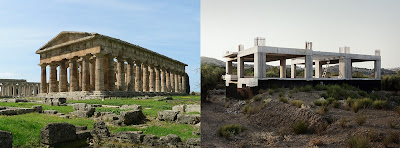Why are different cultures creative in different ways? The building industry in the UK has developed differently to the building industries of different countries. Each appear innovative and creative in distinctly different directions; Prefabrication is more commonplace in the Netherlands, Germany is famous for its efficiency and Japan for the quality of its work etc. The organisational structures of each respective building industry might have their complexities, but they also have similarities. Is there a set of common variables within each which influence its innovation and creativity? If there is, it would be useful to investigate these parallels to see what we can learn.
 |
A partially completed building in Greece.
Reinforced concrete commonly used as the base form of construction.
Picture courtesy of Deserted Places |
For example, construction in Greece appears to focus on a slightly different palette of materials and processes than in the UK. Reinforced concrete is used more frequently to create the base structure, walls and floor plates. This is a procedure requiring one operation (or one repeated operation) with a limited set of skills. It seems to make sense; ready-mixed concrete and cement based materials sourced from local depots are easier to handle and transport than prefabricated building products, where the the geography might consist of uneven roads, islands and other logistical challenges. This is especially useful when other building materials might be difficult to source. Working with a controlled palette of materials, involving a small number of processes managed with commonly known skill sets has its advantages.
But if this system is simple and efficient in Greece, why is it not common practice elsewhere and in the UK? With what might arguably be an a more sophisticated building industry, why are we involved with much more complicated construction processes and protracted procurement methods? Are we missing a trick, blinded by the organisational complexities and market pressures which make up the British Building Industry? Does modernisation and development of the building industry necessarily result in complexity? I believe creativity in the building industry can be divided in to the following key variables divided in to physical issues:
Logistics: Restrictions on the transportation of materials, supplies and labour, combined with the economic consequences of logistical complexities will have a bearing on the choice of materials and building systems.
Climate: Climate dictates the building solution. It also has a bearing on the processes involved to realise the completed building. Some climates might require materials with more thermal mass than thermal resistance for example.
Topography: This relates to logistics and climate, but also to the site and its ground conditions. The typical organisation of site works, access to utilities and service infrastructures will influence a build solution.
Materials: Material resources and availability will have a key influence on the choice of building systems, level of prefabrication, extent of wet trades on site and extent to which labour resources and specialist skills will be required on site.
and cultural, social or political issues:
Language: Does language play a part in creativity? Are some languages better at promoting creativity than others? Do certain languages steer creativity in specific ways? Buckminster Fuller had issues with the ability of language to assist creativity. Adrian Forty describes how language plays a key part in influencing our understanding of the built environment.
Population spread and demographics: The extent of skilled and unskilled labour and their locations relative to project sites. Movement in the economic base of communities affects their population make-up and their requirements from the built environment.
Economic development of the Building Industry: Some economies are more developed than others. Does it follow that the more developed industrial sectors have more complicated organisational structures? Is there anything that can be learnt from simpler industrial sectors? The extent of Industrial development, economic affluence, financial objectives and cultural aspirations play a part in influencing the building industry. Legislation such as planning and building controls, health and safety requirements and accessibility also influence.
Cultural aspirations: History has also shown that industrial capabilities have given way to cultural aspirations and preconceptions of what buildings should look like.
 |
| Development from Paestum to the 21st Century. Progress in structural performance and materials to ease logistical and construction management restrictions. Still looking to simplify the construction process with structural materials, involving a set range of skills and labour, with as few materials and processes as possible. |
Can this be used to explain consistent patterns of development within the building industries of different cultures? In the UK, the wall for example has become a progressively complicated item, requiring more and more stages and processes. In Greece there are similarities between the reinforced concrete building and Paestum: The materials are simple, strong and few. With the substitution of reinforced concrete in place of stone (a key innovative shift to ease structural and logistical challanges), it might be argued that much of the rest of the building process remains the same. Is there something in the culture different nations which sustains their creativity along specific paths for thousands of years? Going back to the original question of what separated the direction of creativity of different cultures, it seems there are distinct cultural anchors which shape our past, present and future.






